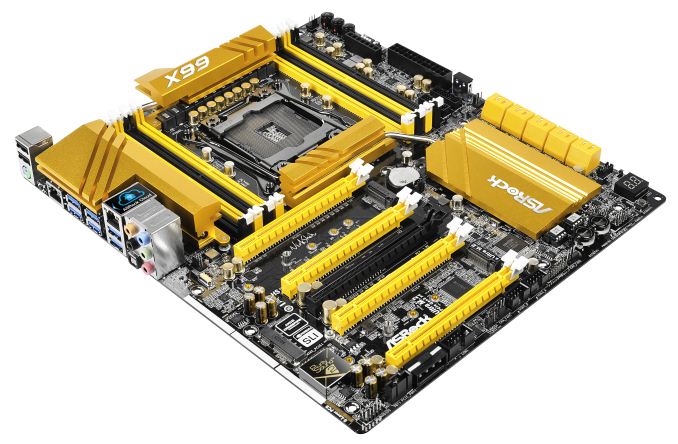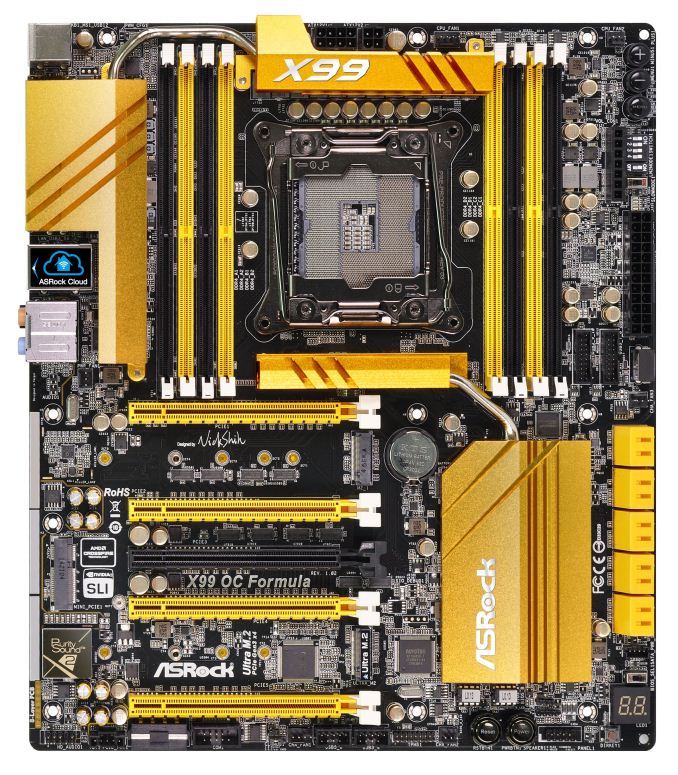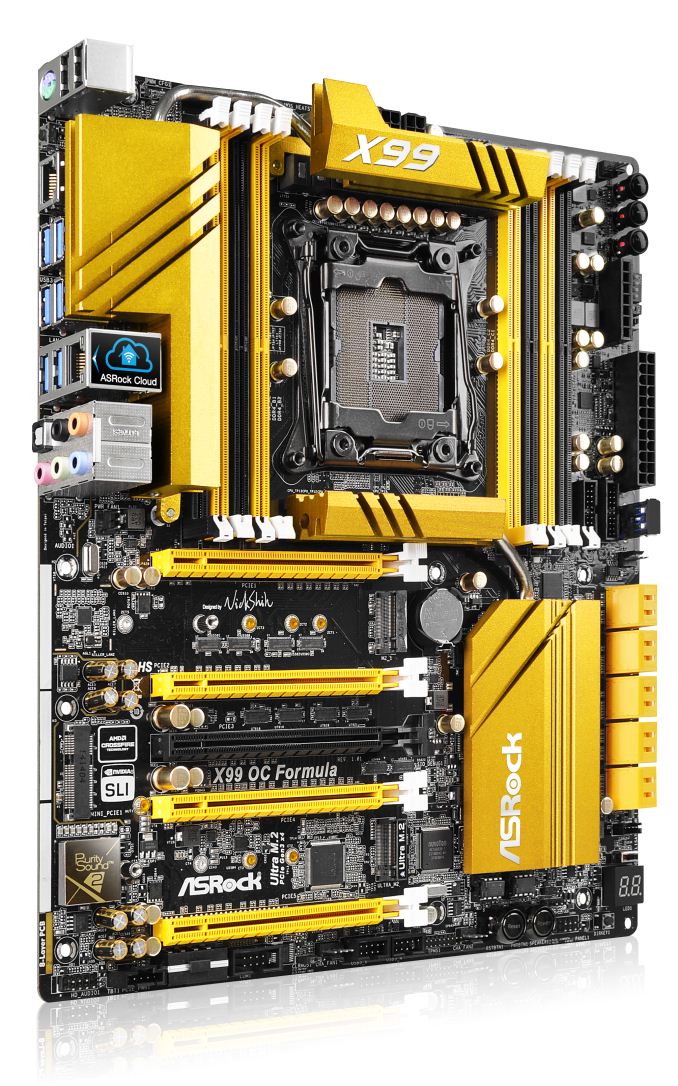Exclusive: ASRock’s X99 OC Formula Motherboard in Pictures
by Ian Cutress on August 25, 2014 6:20 AM EST- Posted in
- Motherboards
- Intel
- ASRock
- Overclocking
- X99

To add another element to the current whirlwind of X99 motherboard shots being released, ASRock has now lifted the lid on its high end overclocking motherboard, the X99 OC Formula. Similar to other OC Formula motherboards, this model is designed by ASRock’s in-house overclocker former world #1 Nick Shih. With the yellow and black livery, ASRock is keen to promote its use of 12 power phases capable of supporting up to 1300W. While regular users will come nowhere near to 1300W, extreme overclockers have (with previous platforms) hit 500W-700W while using liquid nitrogen to push the processors. Given ASRock’s recent push for overclocking records, it makes sense to design a product that can compete. Alongside this feature, ASRock still wants to have a motherboard that regular end-users can use 24/7 with high-end overclocks.
Alongside the new socket, the motherboard will offer 8 DIMM slots and 10 SATA 6 Gbps ports. Instead of SATA Express it looks like there is two M.2 slots, one PCIe 2.0 x4 (sharing lanes with the black slot) and one PCIe 3.0 x4, both supporting up to 110mm drives. Next to the Purity Sound 2 is a half-height mini-PCIe slot, suggesting that there may be a WiFi edition or users can add their own WiFi module. The PCIe slots should allow 4-way Crossfire and SLI, with a central PCIe slot (PCIe 2.0 x4?) that will allow an additional PCIe card for two-way setups.
For overclockers, the X99 OC Formula will have the superhydrophobic Conformal Coating similar to previous models that protects the components on the motherboard from moisture. On the top right of the motherboard are quick frequency change buttons along with voltage check points, a PCIe disable switch, an LN2 mode switch and a slow mode switch. On the rear panel is a ClearCMOS switch, and additional PCIe power is provided by a molex connector.
For regular home users, there are six fan headers, a Thunderbolt header (requires a Thunderbolt PCIe card), a COM header, two USB 2.0 headers, a TPM header and two USB 3.0 headers. There are 10 USB 3.0 ports total including the two headers, and the rear IO shows dual network ports. The connector on the right hand side under the SATA ports is for ASRock's relatively new SATA power feature that makes use of hot-plug functionality to hide drives not in use. I would imagine that the ASRock BIOS and Software are also receiving iterative updates, and the in-the-box contents for OC Formula models in the past have always been interesting. With X99 being an expensive platform by comparison to Z97, I hope that there can be something in there to tantalize everyone.
With all the X99 press shots floating around the media, along with DDR4 pricing going live for pre-orders, things are getting more and more exciting. No word if the ASRock X99 OC Formula will be available at launch, or the release pricing, but I am sure we will know in due course.













33 Comments
View All Comments
hojnikb - Monday, August 25, 2014 - link
Heh, its funny to still see ps/2 ports on a mobo this pricey :)mellozor - Monday, August 25, 2014 - link
I don't understand why it is funny... Sure PS2 is old, but PS2 latency is less than USB. It's not a matter of backwards compatibility, rather giving you the best component support :) http://bit.ly/1wrCL4Bhojnikb - Monday, August 25, 2014 - link
I really dont see anyone using PS/2 keyboards on a system like this. It would be a better use of space to just add two extra usb3.0 portsAnd all that latency is getting really old. If ps2 was really that superior, why is everything usb nowdays ?
AnnihilatorX - Monday, August 25, 2014 - link
That is simply because USB is much more flexible interface. Nevertheless I think there is enough USB ports on this board, if the user wants more, they can simply use a hub. Also, there are already 4+2 USB 3.0 ports. I doubt it can add two extra USB 3.0 ports with out extra USB3.0 controllers + PCI express link requirements. And 3rd party controllers usually suck compared to the intel native implementations anyway.mellozor - Monday, August 25, 2014 - link
@AnnihilatorX You're correct, this X99 has a maximum of 6 USB 3.0 ports and 3rd party controllers suck.@hojnikb it's a simple concept. PS/2 has lower latency and in some cases less data corruption over long cables, but USB beats it hands down in pretty much every other aspect.
I did more research and found that MSI implemented a gaming USB port for low latency USB connectivity on some of their boards, which is neat but I have no idea how it works. Some keyboards like the Steelseries 6gv2 comes with a USB to PS/2 converter and they highly recommend using PS/2 where possible. This quote is Steelseries' reason why: "We absolutely recommend using the PS/2 connector when possible. First,it will give you total freedom with no limit to the amount of simultaneous key presses. And, equally as important, using the PS/2 may just improve your overall gaming experience. The reason is that when you use a USB keyboard your computer is actually using CPU time polling your keyboard. The higher the polling rate the more CPU time is used to perform the polling. And because of the built-in debounce rate found on any quality keyboard, any polling rate above 200Hz is simply a waste of CPU time and really just a result of pointless marketing hype. Unlike USB keyboards a PS/2 keyboard isn’t polled at all. The keyboard simply sends a signal to the computer as key presses are made, which causes a hardware interrupt, forcing the CPU to register the signal."
SirKnobsworth - Monday, August 25, 2014 - link
USB 3 allows device interrupts ... I'm wondering if this could improve these issues somewhat.Morawka - Tuesday, August 26, 2014 - link
3rd party USB 3.0 Controllers are mostly fine. There is negligible benifit from being native.Your probably referring to the 3rd party Sata III controllers, which are far inferior to a native implementation.
Penti - Monday, August 25, 2014 - link
Huh? PS/2 is quite excellent for keyboard support and does N-key rollover. Works great for both old and new keyboards. Doesn't consume CPU-cycles in the same way, or has as much drivers to deal with. It's not like it has tons of COM-ports and Parallel ports.extide - Monday, August 25, 2014 - link
USB can do N-Key rollover too, if the manufacturer isn't a cheapass and uses a decent USB keyboard controller instead of a POS generic one.Samus - Monday, August 25, 2014 - link
USB can't do true n-Key rollover, but the manfuacture can make the key grid more efficient by spacing out the limitations (7 keys simultaneously pressed.) For example, some manufactures take the cluster of AW, SD, QE, RG, ZX, CV and LSHIFT+T and put them on different polling grids, so each of those clusters can be used simultaneously.There is still a poll rate issue with USB simply because PS/2 has a dedicated keyboard controller INSIDE the keyboard AND on the motherboard, bypassing the need for the CPU to monitor the port. USB is a host-based controller and all devices are software-controlled by the CPU, there is no way around this.
Last I checked PS/2 keyboard processors are like 12mhz, so we're not talking a lot of processing power here so the real world impact is negligible. The real benefit of PS/2 is nKey Rollover and the freed up USB port.